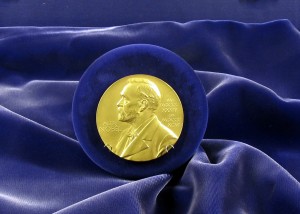By Sarah Marks

Photo credit – Tim Ereneta
For me, one of the most exciting times of the year is in early October, and it’s not just because I love fall leaves, brisk weather, and pumpkin spice lattes. October is when science gets its time in the sun, with the Nobel Prize announcements. A legacy of Alfred Nobel, Nobel Prizes have annually recognized some of the greatest contributions to Physics, Chemistry, Medicine, Economics, Literature, and Peace since 1901.
As a chemist, I pay particular attention to the Chemistry prize. This year’s Nobel Prize in Chemistry was awarded to Jean-Pierre Sauvage, Sir J. Fraser Stoddart, and Bernard L. Feringa “for the design and synthesis of molecular machines.”
What do you picture when you think of machines? Soot covered factories of the Industrial Revolution? Robots out of a post-apocalyptic film?
How about machines that are so small, you cannot even see them? So small, the machine is 1000 times smaller than the width of a human hair? This is the scale of these molecular machines. Touted as the world’s “tiniest Legos”, this year’s prize winners have used organic chemistry to develop molecular machines that can act as a switch, an elevator, and even a car!
While you may think, “Why would I ever need a machine that I can’t see?”, the development of these machines goes beyond just being a novelty item. By working at the nanoscale, these machines have a huge potential to help transport and deliver medications to the appropriate place in our cells, giving us an unprecedented level of precision. But this is just the beginning of the possibilities. What would you use such tiny machines for?
Edited by Christina Marvin
